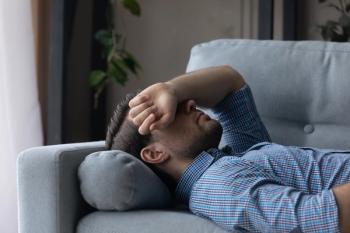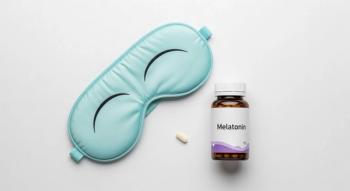
Deconstructing Obstructive Sleep Apnea: Not for Men Only
sleep apnea
Joining the list of disorders studied mostly in white men, yet extrapolated to others, is obstructive sleep apnea (OSA), the repeated occlusion or near-occlusion of the pharynx during sleep. OSA might not actually be on the rise, but recognition of it is, particularly in women. Because OSA is more common among people with Parkinson disease, myotonic dystrophy, myasthenia gravis, Alzheimer disease, and seizure disorders, neurology patients may mention snoring, daytime sleepiness, or inexplicable fatigue, not realizing it is a treatable condition--or a condition at all.
MDs and certain PhDs can earn "certificates of special knowledge" from the American Board of Sleep Medicine (www.absm.org). Not counting the most recent certification exam, 2846 MDs and 147 PhDs are diplomats of the organization. "About 40% of board-certified sleep specialists are neurologists. After all, sleep is about the brain," said Philip Westbrook, MD, chief medical officer of Advanced Brain Monitoring of Carlsbad, CA. He is past president of the American Academy of Sleep Medicine and has been in the field "since all of us could fit into one room."
OSA Basics: More Than A Snore
OSA is a form of sleep-disordered breathing in which breathing stops for 10 seconds or longer a significant number of times per night. The apnea-hypopnea index measures degree of severity: mild OSA is 5 to 15 episodes per hour; moderate is 15 to 30; and severe is more than 30. Hypopnea is a 30% or more reduction in airflow and a 4% drop in blood oxygen saturation.
A less quantitative but equally telling measure of OSA severity is "bed partner satisfaction," for it is often the bedmate who is most aware of snoring. Other signs and symptoms include leg jerks and restlessness during sleep, slowed reaction times, impaired short-term memory, and morning headache that resolves within a few hours. Anxiety, depression, irritability, and decreased sex drive may also occur.
The American Sleep Apnea Association estimates that 12 million people in the United States have OSA, but many more, perhaps 80% to 90% of the true total, are unaware of the problem or do not seek help. Diagnosis is important because of associations between OSA and other conditions, including hypertension, stroke, coronary heart disease, myocardial infarction, and cognitive impairment. In addition, incidence of car accidents is increased 3- to 7-fold among persons with OSA. Presumably, treating OSA can lower the linked risks. However, people have avoided confronting the problem because of fears of sleep labs and torture-like headgear. New diagnostics and therapeutics, however, are making the situation more palatable, so to speak.
Not Just Large White Men
In the past, studies on clinic populations set the male-to-female ratio of patients with OSA at 8 to 10 males to 1 female, said Grace Pien, MD, assistant professor of medicine at the University of Pennsylvania. "But the Wisconsin Sleep Cohort Study1 showed about 3 males per female. We definitely know it isn't rare in women, which was the general thinking," she said. Studies based on the general population place the male-to- female ratio at 2:1 to 4:1. Overall, OSA affects about 4% of men and 2% of women. However, women are more likely to present with fatigue and insomnia, rather than or in addition to the excessive daytime sleepiness and snoring that are the primary symptoms in their male counterparts. "It may not be a classic presentation--the doctor has to do a little more digging to elicit the symptoms of OSA in a woman," Pien added.
Attention also is turning to racial differences in OSA. Michael Friedman, MD, professor of otolaryngology at Rush University Medical Center, and colleagues set up a free ENT screening booth at a large health fair held in Chicago, offering a prize to couples who participated in an interview and assessment of body mass index (BMI) and neck and tonsil sizes. The researchers translated the measurements into a score and tallied results from 500 people: 287 (55%) African Americans and 236 (45%) white persons. (Asians were interviewed but excluded from the analysis.) Results were reported at the annual meeting of the American Academy of Otolaryngology-Head and Neck Surgery, which convened in Los Angeles in September.
More telling than the increased incidence among African Americans was attitude. African Americans were much more likely to consider snoring normal and much less likely to flee a bedroom to avoid hearing it than were white persons. Newspaper reports billed the experiment as "random" because people of different races were equally likely to approach the booth.
Another misconception about OSA that should bite the dust is that most sufferers are obese. A study of 6132 participants in the Sleep Heart Health Study stratified patients with OSA according to BMI and found that 45.5% were obese, 38.1% were overweight, and 16.4% were of normal weight.2 However, obesity is still a powerful risk factor, and the current obesity epidemic may be associated with the increasing incidence of OSA, suggested Meir H. Kryger, MD, director of the sleep disorders center at St. Boniface General Hospital in Winnipeg.
Apples and Oranges Tangle Causes
While studies of OSA are fraught with the usual difficulties of small sample sizes, reporting biases, and different criteria, the causes of the condition are indeed many, interrelated, and not always obvious. The short list includes obesity and variants of fat distribution, postmenopausal status, and nuances of upper airway anatomy and physiology.
"All of these appear to cause OSA, and the contribution of each is not linear," explained J. Catesby Ware, PhD, chief of the Division of Sleep Medicine at the Eastern Virginia Medical School. He offered an example: "If a patient does not have large tonsils, small increases of upper airway tone may be sufficient to maintain a patent airway during inspiration. However, if the tonsils are large enough, no amount of airway tone will keep the airway free of obstruction." To adequately tease apart the causative threads, he added, a study would need to assess OSA before and after tonsillectomy in patients with different sizes of tonsils, weights, neck sizes, and hormonal statuses. Such a study could easily require hundreds of participants, more than most granting agencies will fund, he added.
Gender may dictate which causative factors carry the greatest weight. A study from the Stanford University School of Medicine sleep clinic, for example, suggests that for women, obesity is the primary cause, whereas for men it is upper airway abnormalities, such as longer soft palates, lower hyoid bones, and larger neck circumferences.3 Women have stiffer upper airways. Also, in men with OSA, the muscles that dilate the upper airway--the genioglossus and the tensor palatini--are more active in the men while awake than in affected women. This suggests that these muscles may be more important during sleep in men.
Increased risk with aging is striking in women compared with men. In a study of 215 men and 215 women stratified by age, the average number of apnea events per hour changed with age from 27 to 30 to 34 in men, but from 15 to 13 to 26 in women.4
The fat factor is not merely a matter of amount, but distribution. High BMI appears to be a greater risk factor for men because a man's weight tends to settle in higher regions of the body, whereas it settles around the waist and hips in women.5 Even men with OSA who maintain a healthy weight tend to have fatter necks.
Once women hit menopause, risk rises. It may seem paradoxical that both obesity, which presumably ups estrogen, and menopause, which depletes it, are risk factors, but Kryger pinpointed progesterone as the culprit. "Progesterone has a powerful protective effect before menopause. For a premenopausal [woman] to have sleep apnea, she has to be really overweight, with a BMI of 55." The protection mechanism may reflect the fact that progesterone increases sensitivity to oxygen and CO2 levels in the blood. Menopause also alters fat distribution so that fat begins to pad the neck.
Because of OSA's association with excess weight, OSA can develop during pregnancy. Pien has found that sleep-disordered breathing occurs more frequently during pregnancy, but severe apnea is unlikely to develop in a woman who has never had OSA. However, mild cases can and do arise. "During pregnancy, estrogen can be 20 to 200 times higher than in a normal cycle, which can cause puffiness and rhinitis of pregnancy. The upper airway slightly swells, and the uterus pushes up the diaphragm, changing the mechanics of the chest. Neck circumference may also increase a little," she said.
The long-recognized association of OSA with menopause has suggested that hormone replacement therapy (HRT) could lower the risk. But results have been mixed. "The studies are apples and oranges. Nobody has really done a placebo-controlled randomized clinical trial," Kryger said. According to Pien, smaller studies have differed in hormone combinations, dosages, and durations, whereas epidemiologic studies often raise questions of self-selection. "That is, does a population of women who've chosen HRT differ from women who haven't?" she asked.
Ware suggested that levels of HRT might need fine-tuning to have an effect. "There may be a critical threshold in that once OSA begins, HRT might not reverse it. But if started earlier enough, HRT might have prevented it from developing. It is also possible that the hormonal status is a red herring. This is a question to be answered by research." Given that HRT has been prescribed more conservatively in the years since many studies on OSA were done, ethics committees might hesitate to recommend further study of HRT in OSA, Kryger said.
Considering the prevalence of OSA and its possible complications and the new identification of susceptible populations, neurologists should not overlook OSA in the differential diagnosis. Summed up Pien, "One important message is that menopause does appear to increase the risk, so women who have difficulty sleeping or daytime sleepiness, as they go through menopause or after, should be aware that this is the possible etiology of the symptoms, and should seek evaluation. OSA can be effectively treated." *
REFERENCES
1. Young T, Finn L, Austin D, Peterson A. Menopausal status and sleep-disordered breathing in the Wisconsin sleep cohort study. Am J Respir Crit Care Med. 2003;167:1181-1185.
2. Nieto FJ, Young TB, Lind BK, et al. Association of sleep-disordered breathing, sleep apnea, and hypertension in a large community-based study. Sleep Heart Health Study. JAMA. 2000;283:1829-1836.
3. Guilleminault C, Quera-Salva MA, Partinen M, Jamieson A. Women and the obstructive sleep apnea syndrome. Chest. 1988;93:104-109.
4. Ware JC, McBrayer RH, Scott JA. Influence of sex and age on duration and frequency of sleep apnea events. Sleep. 2000;23:165-170.
5. Kapsimalis F, Kryger MH. Gender and obstructive sleep apnea syndrome, part 2: mechanisms. Sleep. 2002;25:499-506.
DIAGNOSING AND TREATING OSA
Diagnosing obstructive sleep apnea (OSA) has traditionally entailed a stint in a sleep laboratory, where polysomnography was used to monitor brain waves, rapid eye movement (REM) sleep, muscle activity, heart rate, air flow, breathing, and blood oxygen saturation. When pulmonologist Philip Westbrook, MD, chief medical officer of Advanced Brain Monitoring Inc. of Carlsbad, CA, ran the sleep laboratories at the Mayo Clinic and Cedars-Sinai Medical Center, he "came to believe that the standard paradigm for the diagnosis and evaluation of sleep apnea was ridiculous." He believed that the relevant information could be obtained more simply--and less expensively--at home. So with engineers at the company, he developed the Apnea Risk Evaluation System (ARES).1
The recording mechanism of the lightweight device, called the Unicorder, assesses blood oxygen saturation, pulse, head movement, head position, snoring sounds, and nasal pressure. The flash memory can store information from 2 nights, and the patient can simply mail the device to the sleep laboratory for downloading. Future models will include electroencephalographic and REM/nREM measurements, Westbrook added.
ARES is worn on the head, resembling spotlight-outfitted headgear used for cave exploration, and a 2-day full report costs about $250. In comparison, a night's stay at the sleep laboratory costs about $1500. Although ARES results are as accurate as those from a sleep laboratory, Westbrook cautions that ARES should only be used by patients who do not need to be attended.
Treatment of OSA has ranged from behavioral interventions--from weight loss to not sleeping on the back to avoiding alcohol and sleeping pills--to surgery to reconfigure the airway. Other interventions have included radiofrequency ablation, sclerotherapy, and laser-assisted uvulopalatoplasty.
The gold standard has been continuous positive airway pressure (CPAP). "A mask fits over the nose and is connected to a machine about the size of a shoebox that sits on the table. This prevents the airway collapse that is characteristic of OSA," said Grace Pien, assistant professor of medicine at the University of Pennsylvania. Although several variations on the CPAP theme have attempted to make it less cumbersome--and an odd urban legend persists about a group of traveling salesmen who take their CPAPs with them--patients still complain of irritation, dry skin, sore eyes, and headaches.
Reports of CPAP adherence of 40% to 50% are "grossly overstated," said Jason Van Tassel, MD, a fellow in otolaryngology at the University of California at Irvine Medical Center. As an alternative, he has patients use the Pillar Palatal Implant System, marketed by Restore Medical of St. Paul, MN. So far, 20 patients have used it--and they love it, Van Tassel said.
It is an implant of 3 polyester fiber rods embedded in the soft palate near the boundary with the hard palate. The implant, as well as the body's response to it, stiffens the palate, altering the physical conditions that lead to airway collapse. Although the FDA approved it in 2004 as a "substantial equivalent" to existing devices that alter the airway in other ways, evidence for stand-alone efficacy is mounting.2 A study in press that was presented at the annual meeting of the American Academy of Otolaryngology-Head and Neck Surgery in Los Angeles in September reported that 83% of 125 patients experienced reduction in daytime fatigue and improvement in quality of life after receiving the implants.
The key to success with the Pillar implants, said Van Tassel, is patient selection. "The patient should not be overweight nor have a huge tongue or tonsils or nose problem. The most common problem in OSA is a palate that flops down." He uses a local anesthetic for the 10-minute procedure, which insurance does not yet cover. Implantation, including evaluation, costs $1500 to $2000. All of Van Tassel's patients have had improvement within 3 months. "You just have to pick your patients well, and it's a slam dunk," he said.
REFERENCES
1. Westbrook PR, Levendowski DJ, Cvetinovic M, et al. Description and validation of the apnea risk evaluation system: a novel method to diagnose sleep apnea-hypopnea in the home. Chest. 2005;128:2166-2175.
2. Huang Y, White DP, Malhotra A. The impact of anatomic manipulations on pharyngeal collapse. Chest. 2005;128:1324-1330.
Newsletter
Receive trusted psychiatric news, expert analysis, and clinical insights — subscribe today to support your practice and your patients.

















